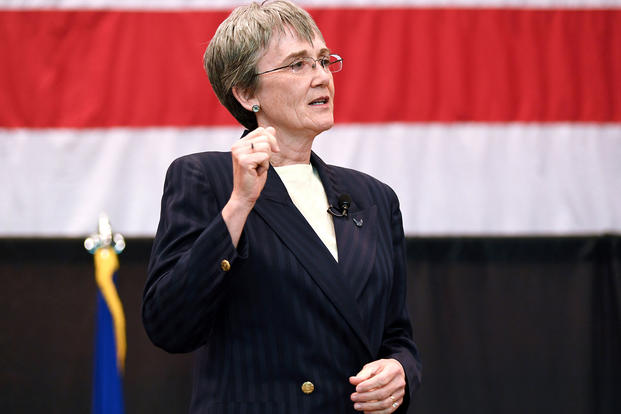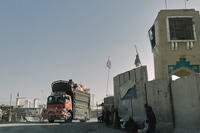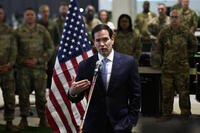ABOARD A C-37 MILITARY AIRCRAFT -- The conversation surrounding the creation of a U.S. Space Force has brought with it skepticism and confusion, but also a spotlight on reinforcing space operations as a national security priority for the foreseeable future.
As the Defense Department crafts its sixth military branch, one thing leaders may not be thinking about is how best to develop "space warfighters" as Space Force comes online, according to the Air Force's outgoing top civilian.
"I think there's still a lot of work to be done in the area of, 'How do we develop officers and enlisted for a contested domain?'" Air Force Secretary Heather Wilson said during an exclusive interview with Military.com on Tuesday.
Military.com traveled with the outgoing secretary on one of her last trips to Air University at Maxwell Air Force Base, Alabama, before she departs the Pentagon in the next two weeks to take her new position as president of the University of Texas at El Paso.
Related: SecAF Wilson: Mattis' Departure Made it Easier for Me to Resign
Wilson said she wouldn't necessarily say there are "shortfalls in the Pentagon's proposal" but added, "I think I've been clear about my concerns about the Space Development Agency."
Any new developments will take time to mature, especially when training and preparing people, she explained.
The Pentagon is requesting $72.4 million in fiscal 2020 to bring together manpower and resources at the headquarters level and $2 billion over five years to fund the Space Force. According to a new report from the Congressional Budget Office, that number could balloon.
While Space Force will fall under the Department of the Air Force, according to a directive signed by President Donald Trump in February, the service so far has oversight only over Space Force's initial creation, allocating dollars out of its budget as the first step in implementing the DoD's long-term vision.
The Air Force on Tuesday announced the candidate bases that could headquarter U.S. Space Command, the unified combatant command that the Trump administration sees as the stepping stone to creating a U.S. Space Force. Most of the options are in Colorado, including Buckley Air Force Base, Cheyenne Mountain Air Force Station, Peterson Air Force Base, and Schriever Air Force Base. Other options are the Army's Redstone Arsenal in Alabama and Vandenberg Air Force Base in California. The list is the same as reported by CNN in April.
Wilson said her successor will make the decision after an environmental assessment and other evaluations.
But legislative, budgetary and geographical hurdles aside, Wilson said she is most concerned about culture change at the Space Force -- the identity of the service, and how personnel will develop, be promoted and execute their roles to the utmost potential.
"We can change a lot of strategies and concepts of operations and programs, which we have, and we've added significant dollars to the budget that are changes to the organizational structure, but culture change is [harder]," she said.
"I think over the long term, the culture of units in shifting from a mentality of operating a utility to being a warfighting component is a change that takes more time," she said. "I think it's going to take longer."
She added, "It has to do with, 'How do we train people? How do we develop them? How do they spend their time?'"
Wilson said a boost in training development has already started, which will help mold how an operator thinks, especially in a time of crisis in a space mission.
"We have 24/7 operations at the Space Warfighting Center [at Schriever Air Force Base], where people spend four months in the ops center operating satellites and then four months off the floor doing warfighting practicing," she said. "So we're bringing a lot more simulation, which is what we do for air combat, bringing more simulation in so that you can, as a warfighter, practice all kinds of different scenarios. And, in some ways, it's even easier in space, because you never see your equipment anyway. You're always just operating in what is a highly technical but disconnected environment. So we can use a lot of simulation modeling to help people think through different scenarios in space. And train constantly that way for the day when things go wrong.
"That's starting to be the mode of operations, but it's a different culture, and it's going to take time. It's a change over time," Wilson said.
-- Oriana Pawlyk can be reached at oriana.pawlyk@military.com. Follow her on Twitter at @Oriana0214.












